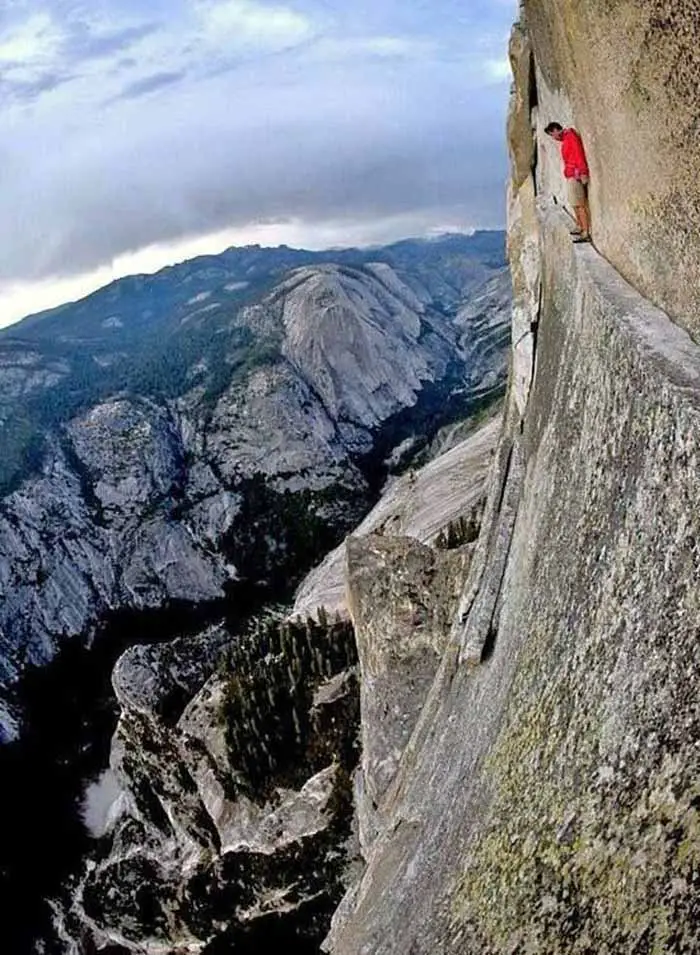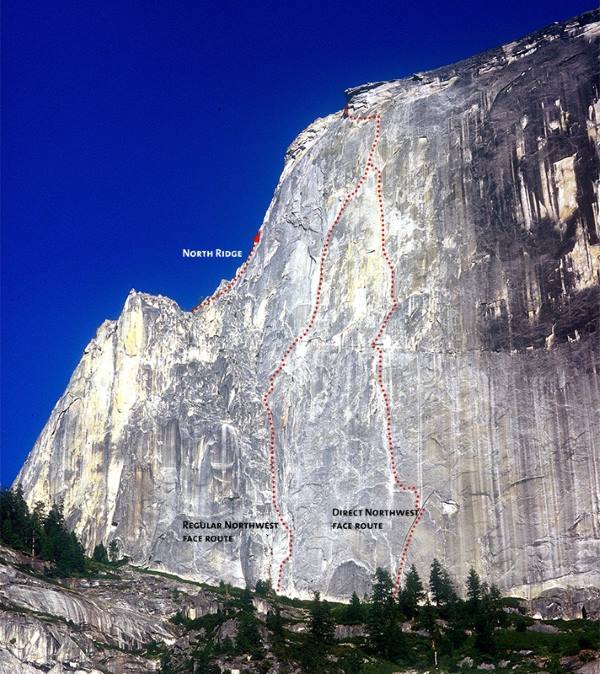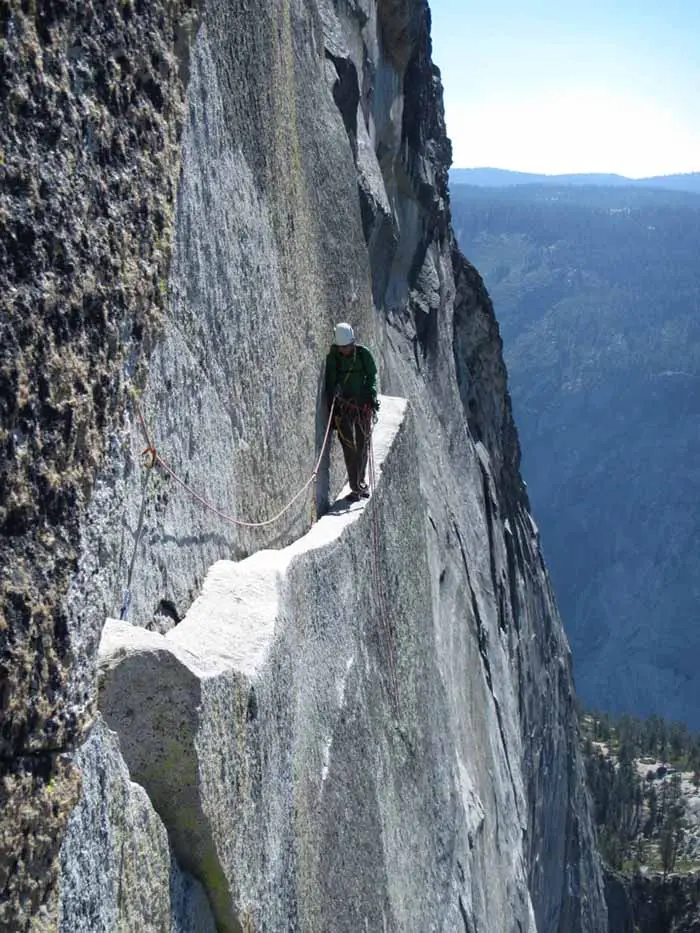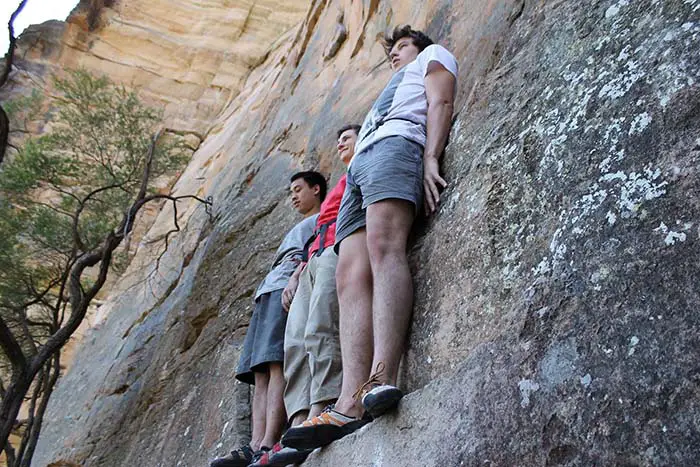Climbing destinations don’t get any more iconic than Yosemite National Park. The park is the setting for some of the most legendary routes, feats, and climbing folklore that have left a profound mark on climbing history.
For starters, there’s Camp 4 campground, a place cutting-edge climbers have been calling home since the early 70s. Or Midnight Lighting, one of the most famous boulders on the planet. And who could forget El Cap? This gigantic, totally sandbagged Granite slab that towers over the Valley is steeped in so much history you could fill an entire library with the tales of its countless daring ascents and inspiring feats of human strength.

Just eight kilometers down the road from El Capitan stands another imposing landmark that is hard to miss – Half Dome. Half Dome is about as famous as large chunks of granite get and has long been a prized line for big wall climbers. But did you know that it is also the inspiration behind the logo and name of The North Face? It’s no wonder that Half Dome is one of the most recognizable mountains on the planet.
Venture up 1,700 feet on the imposing Northwest Face of Half Dome and you’ll discover a feature that has become famous worldwide – the Thank God Ledge.

Don’t let the name fool you; it has no religious connotations. Instead, Thank God Ledge earned its name because it’s a crucial feature that bridges two pitches on the Northwest Face of Half Dome. Without it, the established route would be unclimbable.
But if you’re craving a more intriguing story behind its name, keep reading below.
Why Is It Called Thank God Ledge?
Like many legendary tales of Half Dome, it all begins with the epic first ascent in 1957, led by Royal Robbins, Jerry Gallwas, and Mike Serrick. At only age 22, Robbins and his team embarked on a bold five-day ascent of the Regular Northwest Face.

At the time, it marked a monumental leap forward in rock climbing. It was not only the first Grade VI wall to be conquered in the United States but also one of the most audacious attempts on a sheer rock wall ever undertaken. The paradigm-shifting ascent paved the way for the untapped potential of big-wall climbing across Yosemite, as well as the rest of the country.
Robbins and his crew set out on their audacious five-day push up the 23-pitch route, adhering to their clean climbing ethics wherever possible, and sparingly using the 45 pitons they had brought with them. When the team did reach a blank section on the face, they would spend hours tediously hand-drilling expansion bolts into the Granite walls, with one pitch taking Gallwas five hours to place seven bolts.
After four grueling days spent ascending the formidable wall, the summit was tantalizingly close, hanging just a few hundred feet above. On a crucial pitch, Gallwas took the lead, but as the cracks began to thin, the climbing was becoming desperate.
He ground to a halt with the overhanging brim looming just out of reach, casting doubt on whether the team would be able to complete their ascent, despite coming agonizingly close.
The prospect of downclimbing wouldn’t come without its challenges either. The team had pulled off some pretty bold moves to get to this point. At one point, Robbin executed a nerve-racking pendulum swing to a link lower section on the route. None of the team were psyched on the idea of trying to reverse their climb.
Gallwas inched his way up, frequently leaning out and peering around, desperately searching to find a path through the labyrinth of granite.
Suddenly, he exclaimed, ‘A ledge!’ There’s a ledge! An amazing ledge.’”

The ledge, approximately 35-foot length, was a lifeline to Robbins and his crew. This miraculous creation of nature acted as a bridge, guarding the entrance to the final few pitches of the climb. The team crawled along the ledge to reach the accessible 5.9 crack and made the final push to the top of the mountain.
After five days of some of the boldest climbing the world had ever witnessed, Royal Robbins, Jerry Gallwas, and Mike Serrick stood on the top victorious.
What Makes It So Special?
While any ledge on a big wall, or even a single-pitch route, can be a valuable resting spot, not all ledges are created equal. The Thank God Ledge On Half Dome certainly isn’t the biggest or the most comfortable ledge on the climb. Lower ledges like Big Sandy and the Grand Terrace take those titles.

In fact, this “disturbing narrow” ledge, as Royal Robbins described it, is far from what you would consider a comfortable recovery spot, which is most likely why it has captured the attention of both climbers and non-climbers alike.
At 35ft (12 meters) in length, and just under a foot in width at its narrowest section, the Thank God ledge makes for a nerve-racking traverse. This isn’t helped by the fact that as you begin the traverse, the ledge begins to slope under your feet, and bulges behind your back, pushing you precariously off balance.
For this reason, despite many good intentions, most climbers opt to crawl along the ledge, as opposed to casually strolling across, like most envision whilst standing comfortably on the ground.
Alex Honnold On The Ledge
While Robbins, Gallwas, and Serrick may have been the first climbers to stand on the landmark, Alex Honnold played a significant role in elevating its notoriety.
Off the back of his incomprehensible free solo ascent of Half Dome in 2008 Sender Films teamed up with Honnold to recreate some footage of the ascent. One of the scenes from their feature film, Alone On The Wall, captured Alex Honnold ropeless on the Thank God Ledge. With his back pressed against the towering wall, he slowly inches his way along the narrow ledge, showcasing his unparalleled skill and nerve.

Again in 2011, Honnold joined forces with Jimmy Chin to recreate the famous image, this time for a feature that National Geographic was running on the next generation of Yosemite climbers. The iconic image instantly became a viral sensation, and even today remains one of the most celebrated photos in climbing history.
The Ball Watch Company even used it for a full-page advert in the New York Times Magazine, along with Honnold saying the phrase “The watch that rocks” – despite never actually wearing a watch, of any kind, whilst climbing.
The image became so iconic that it gave birth to a meme known as “Honnolding.” People from all corners of the globe shared their own ledge poses, albeit closer to the ground.

Thank God Ledge Deaths
Despite the intimidating width and vertigo-inducing drop, as of 2023, there are no recorded deaths on the Thank God Ledge.
In fact, many of the deaths on Half Dome aren’t related to rock climbing at all, but instead from the millions of hikers who opt to undertake the “Half Dome Trail”. With as many as 1200 visitors undertaking the hike during peak tourist season, 9 deaths have been recorded on the infamous cable section of the route, with the most recent death being in 2019. Because of the high casualty rate, the park introduced a permit restriction in 2010, limiting the number of hikers to only 300 per day.
Watch this terrifying climb on the Thank God Ledge:

FAQs
.




Been there, looked at it. Climb it? Nooooo!
😅